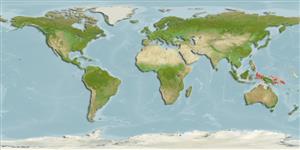>
Gobiiformes (Gobies) >
Gobiidae (Gobies) > Gobiinae
Etymology: Eviota: No etymology given, suggested by Christopher Scharpt: from Latin 'eu' for 'true' and 'iota' for anything very small, in combination 'truly very small' referring to it as being the smallest vertebrate at the time it has benn described by Jenkins (thus, making the suggestion by Scharpt plausible; epistigmata: Name from Greek combination of 'epi' meaning over, and 'stigmata', meaning spot or mark, referring to the dark mark on the upper portion of the caudal peduncle.
Environment: milieu / climate zone / depth range / distribution range
Ecología
marino asociado a arrecife; rango de profundidad 1 - 5 m (Ref. 96083). Tropical
Western Pacific: Indonesia and Papua New Guinea.
Tamaño / Peso / Age
Maturity: Lm ? range ? - ? cm
Max length : 1.6 cm SL macho / no sexado; (Ref. 96083)
Short description
Claves de identificación | Morfología | Morfometría
Espinas dorsales (total) : 7; Radios blandos dorsales (total) : 8; Espinas anales: 1; Radios blandos anales: 7 - 8; Vértebra: 26. This species is distinguished by the following characters: fifth pelvic-fin ray absent or rudimentary; dorsal to anal fin-ray formula 8/8; 5 or fewer dark internal spots or bands between anal-fin origin and caudal fin; no distinct markings on pectoral-fin base; similar with E. nigramembrana, it has a small, dark occipital spot; differs from E. nigramembrana by not having an obvious area of dark pigment on the opercular membrane; edges of the scale pockets are more heavily pigmented than E. nigramembrana; has a dark internal mark above the midline of the ural centrum (vs. on the middle of the centrum in E. nigripinna and over the entire centrum in E. winterbottomi); dorsal fin dark dusky basally and marginally, pale or light dusky in central portion of fin (Ref. 96083).
Life cycle and mating behavior
Madurez | Reproducción | Puesta | Huevos | Fecundidad | Larva
Greenfield, D.W. and S.L. Jewett, 2014. Two new dwarfgobies from the Western Pacific (Teleostei: Gobiidae: Eviota). Copeia 2014(1):56-62. (Ref. 96083)
IUCN Red List Status (Ref. 130435: Version 2024-2)
Threat to humans
Harmless
Human uses
Herramientas
Special reports
Download XML
Fuentes de Internet
Estimates based on models
Preferred temperature (Ref.
123201): 28.4 - 29.2, mean 28.8 °C (based on 399 cells).
Phylogenetic diversity index (Ref.
82804): PD
50 = 0.5000 [Uniqueness, from 0.5 = low to 2.0 = high].
Bayesian length-weight: a=0.00692 (0.00284 - 0.01683), b=3.10 (2.92 - 3.28), in cm total length, based on LWR estimates for this Genus-body shape (Ref.
93245).
Nivel trófico (Ref.
69278): 3.0 ±0.3 se; based on size and trophs of closest relatives
Resiliencia (Ref.
120179): Alto, población duplicada en un tiempo mínimo inferior a 15 meses (Preliminary K or Fecundity.).
Fishing Vulnerability (Ref.
59153): Low vulnerability (10 of 100).
